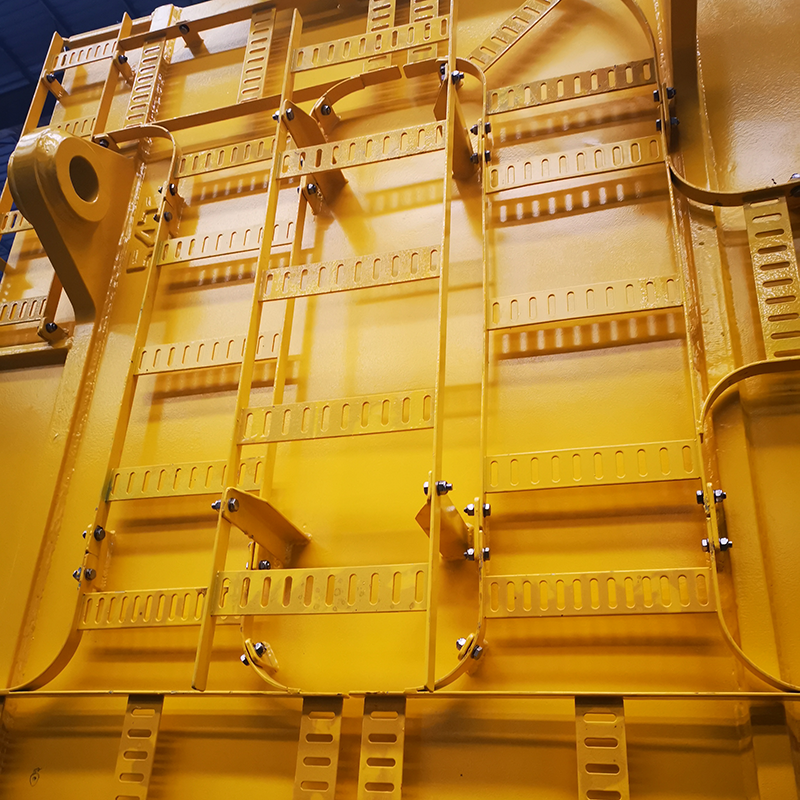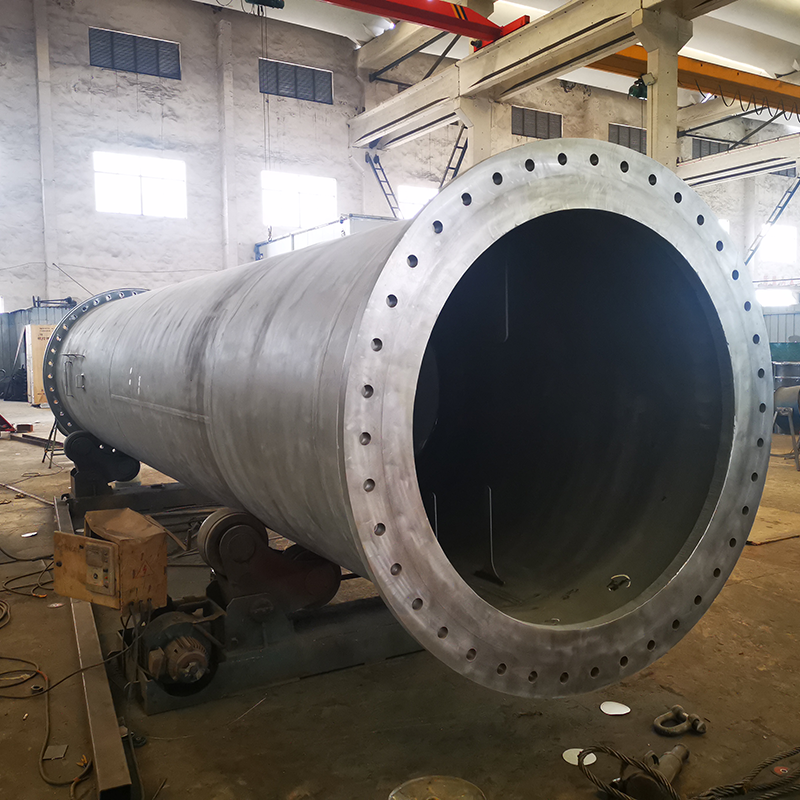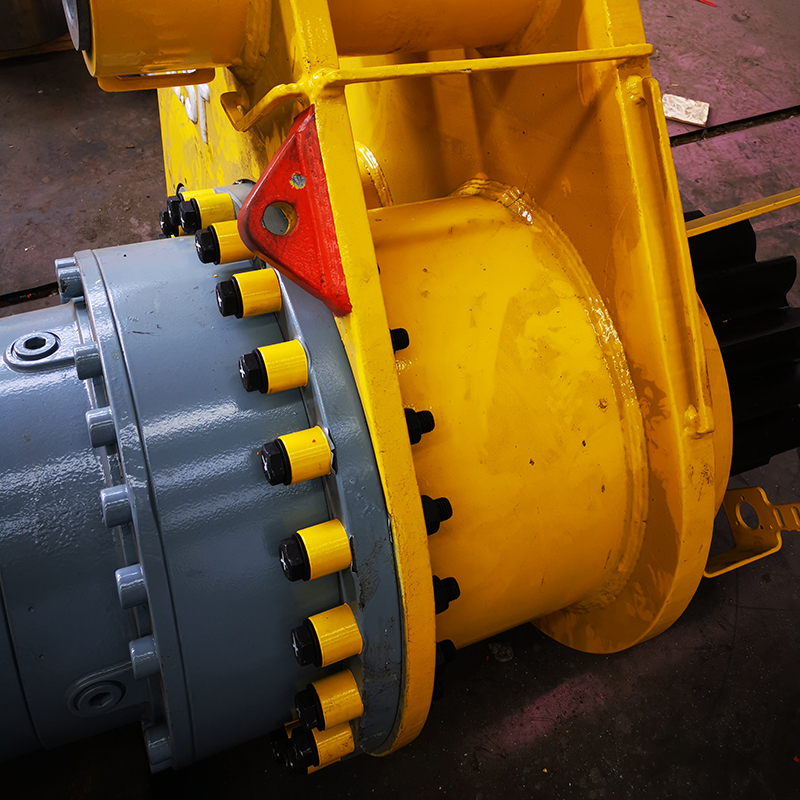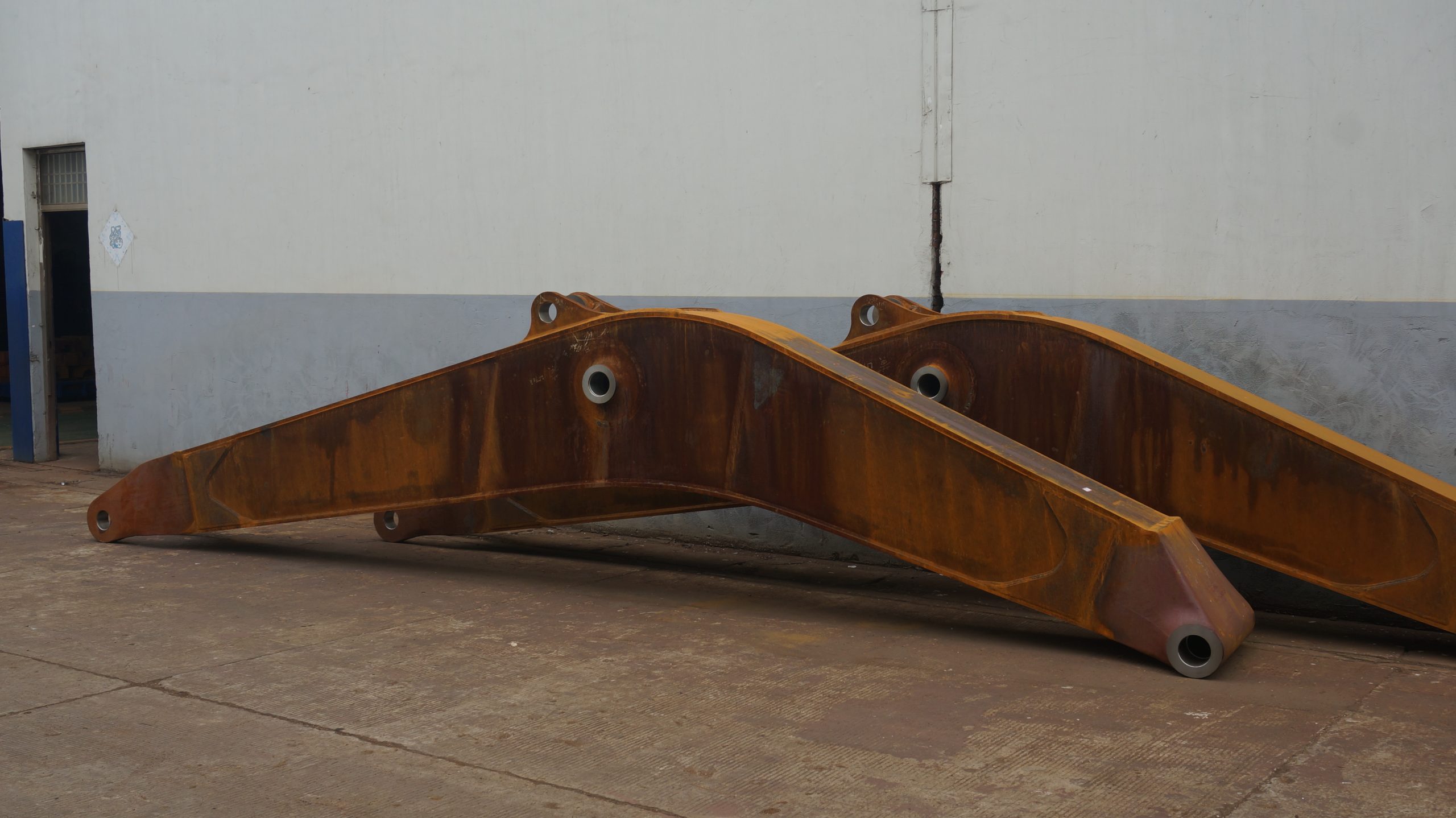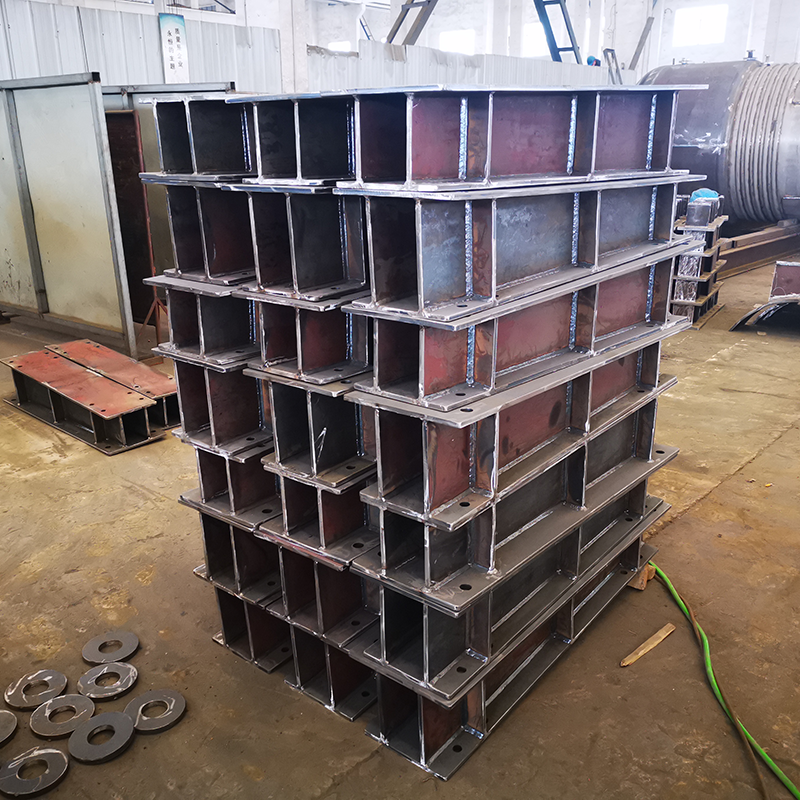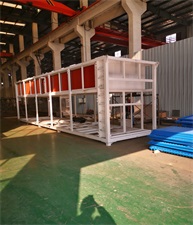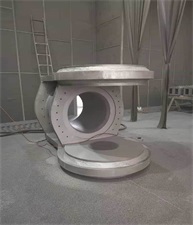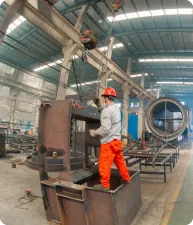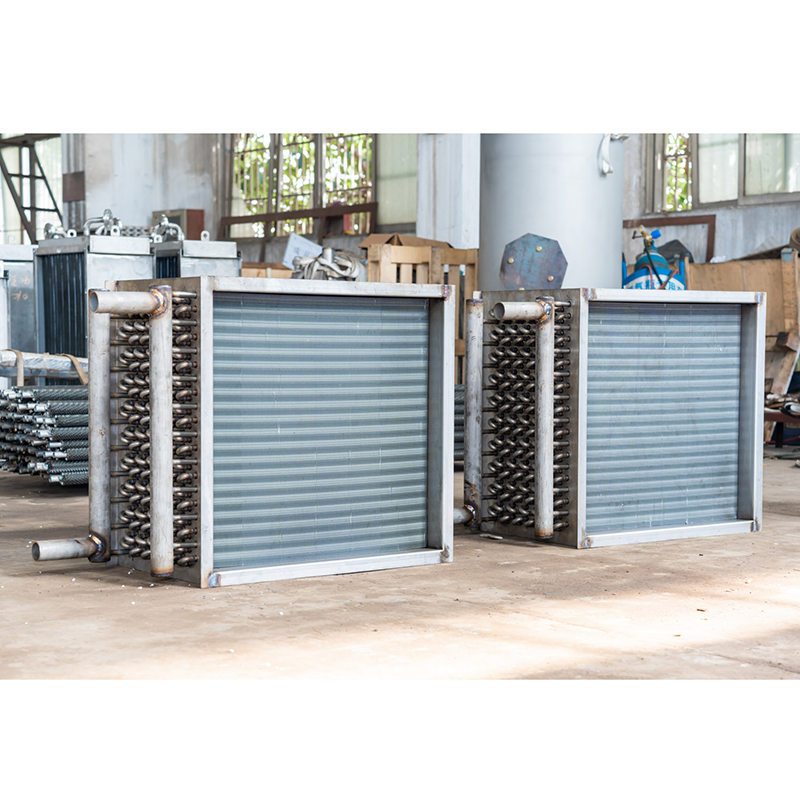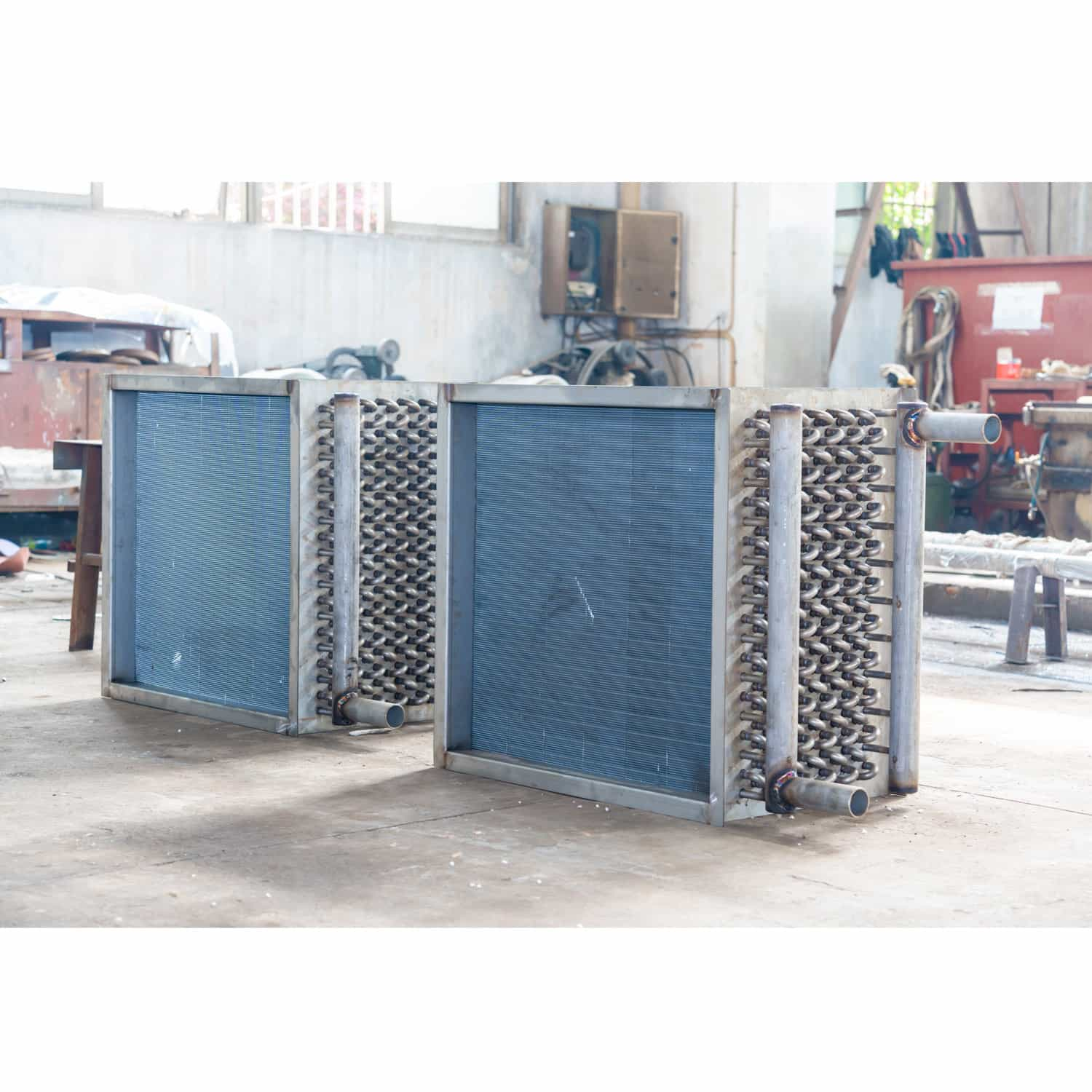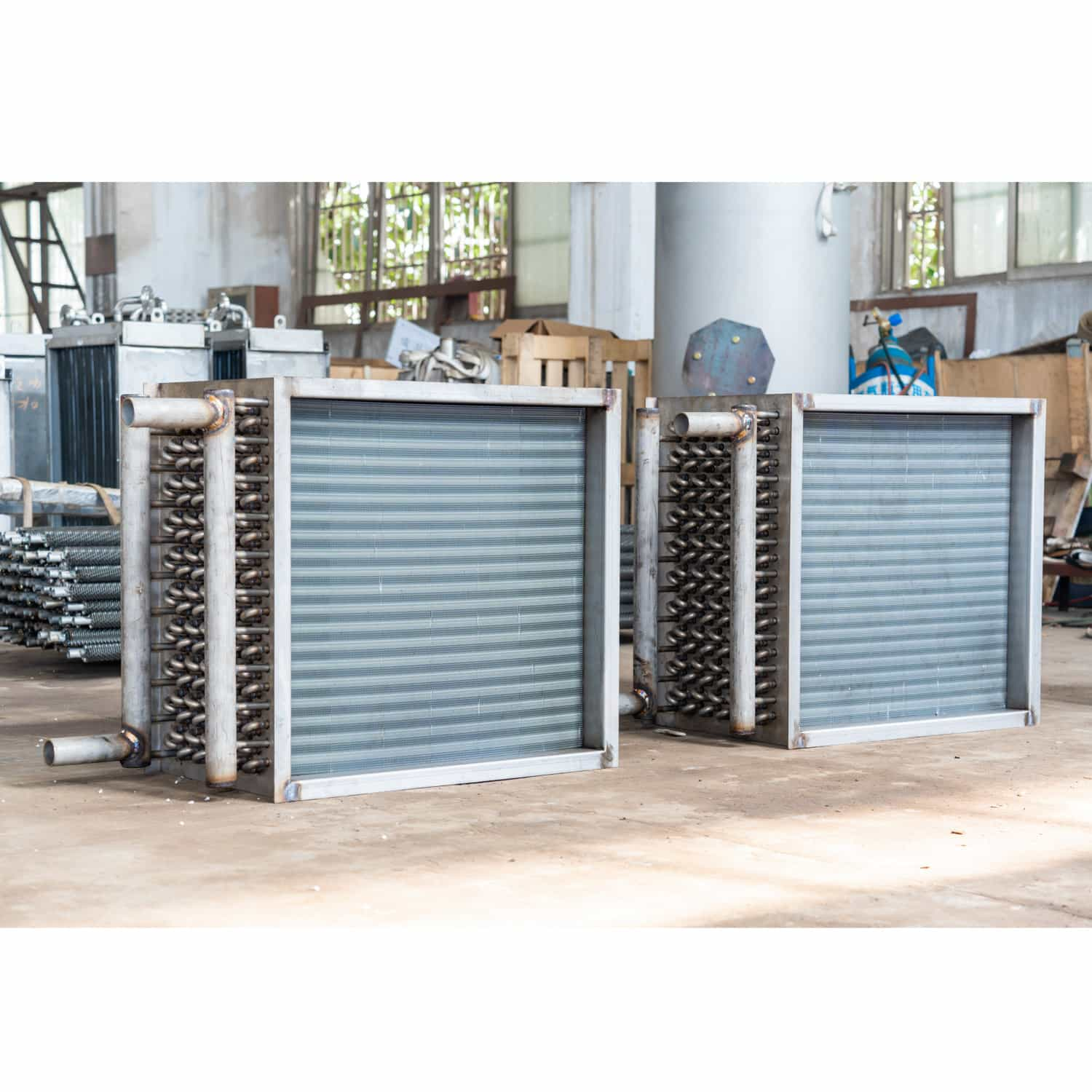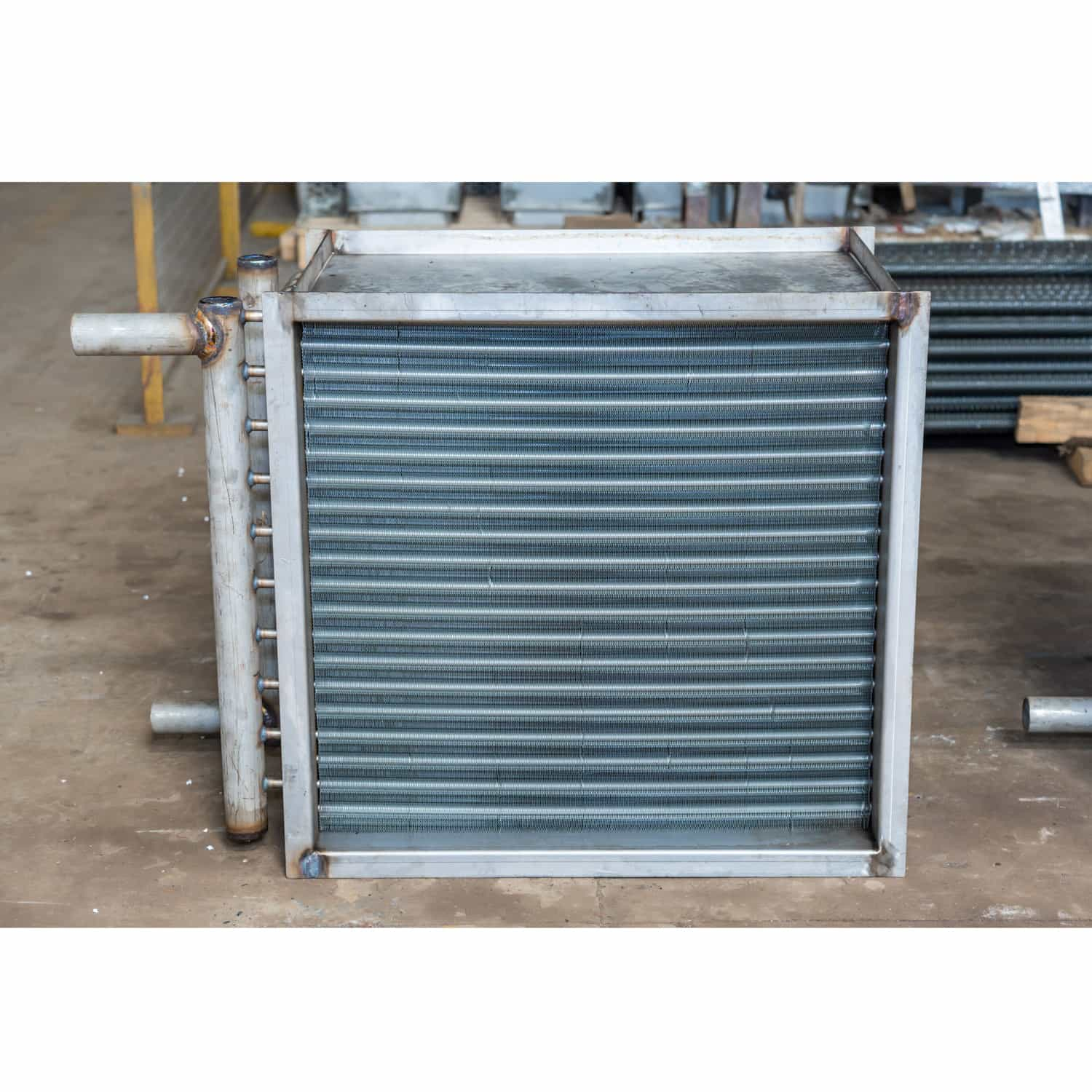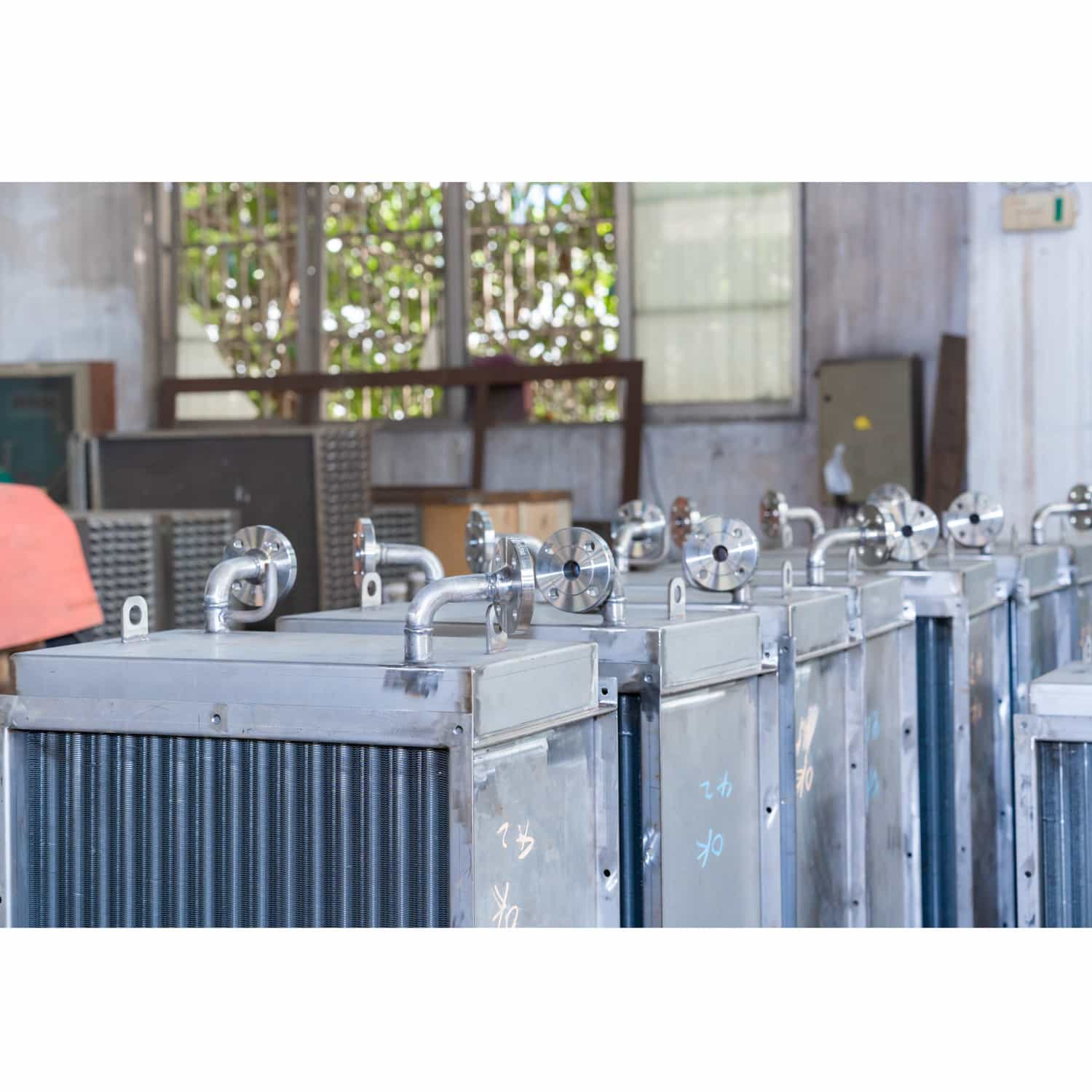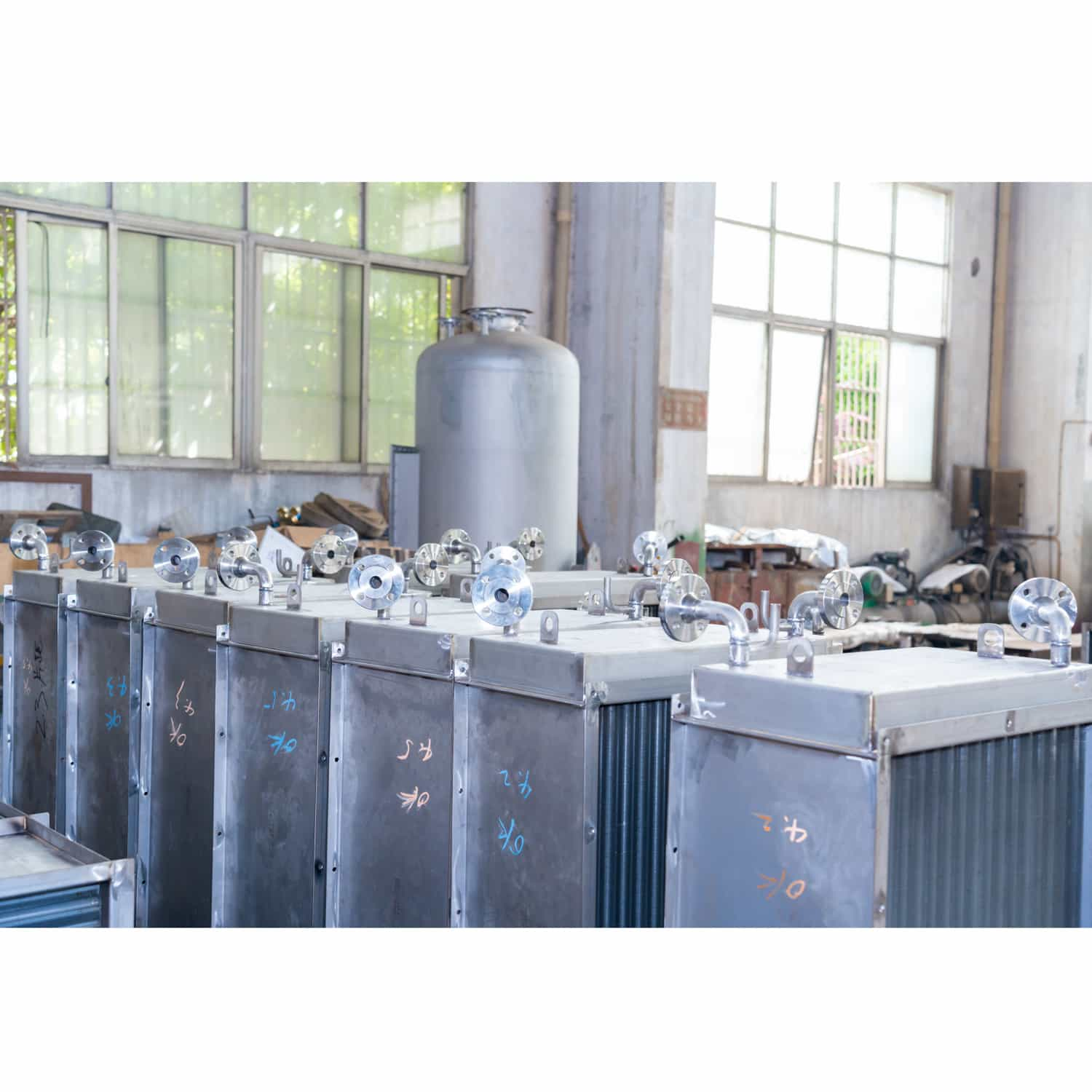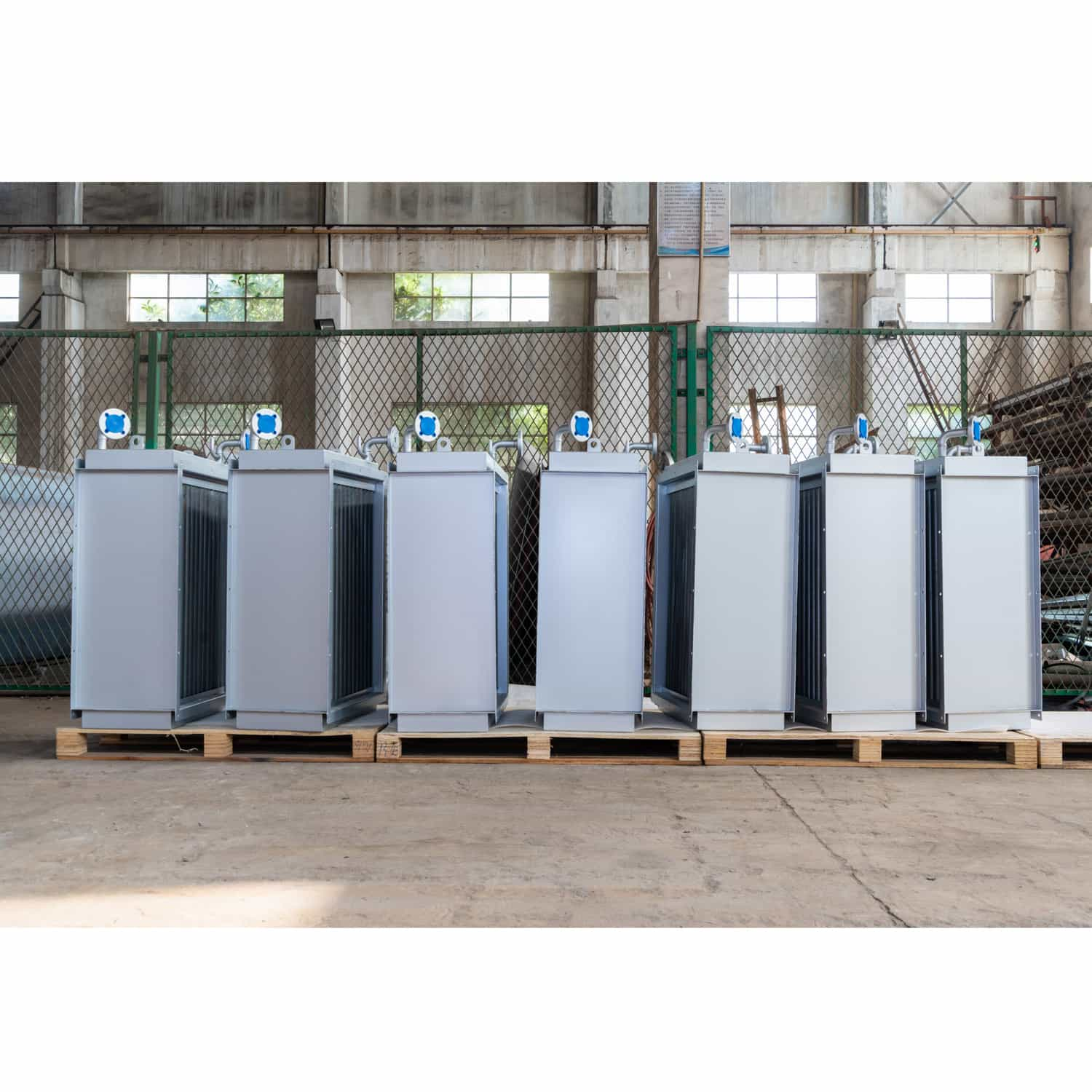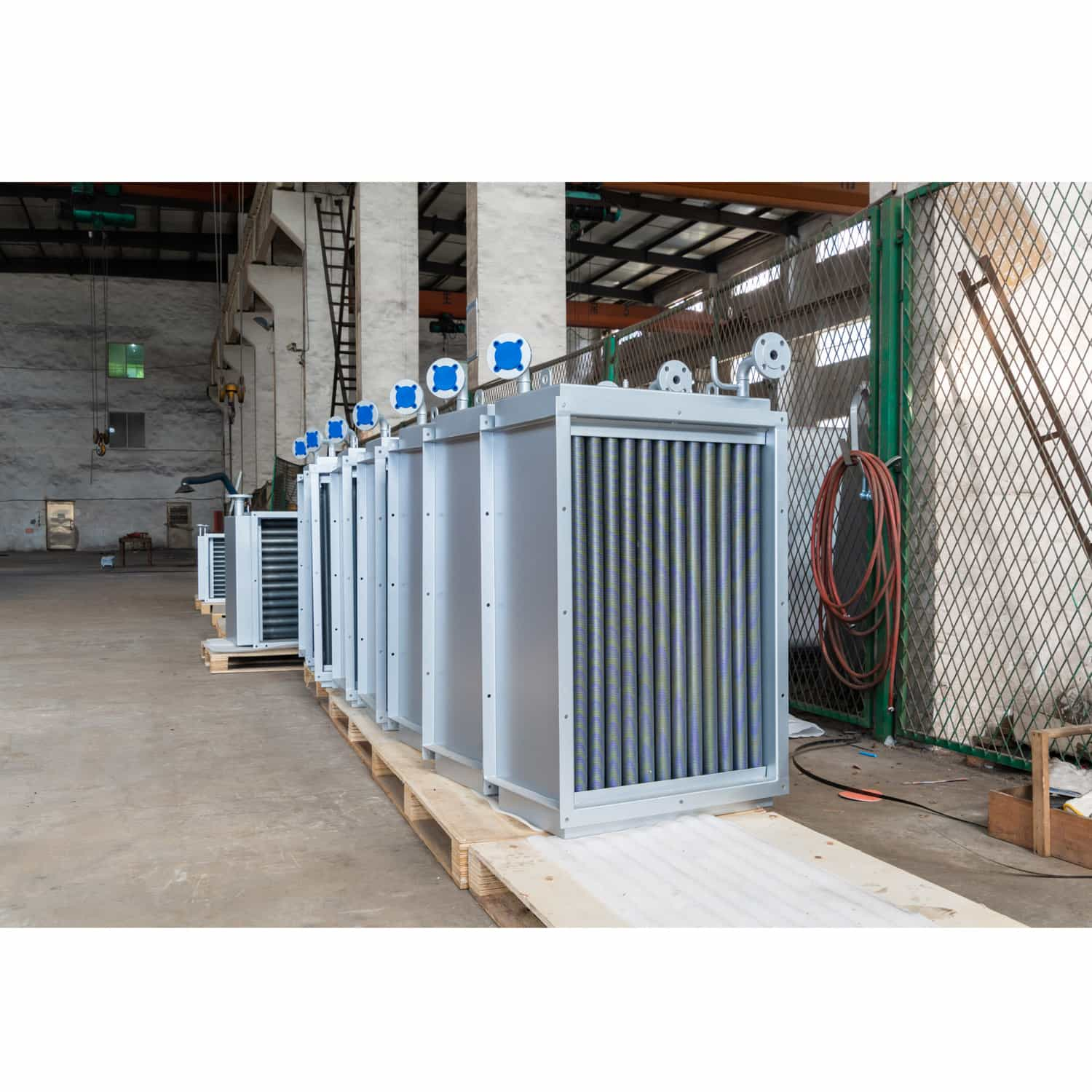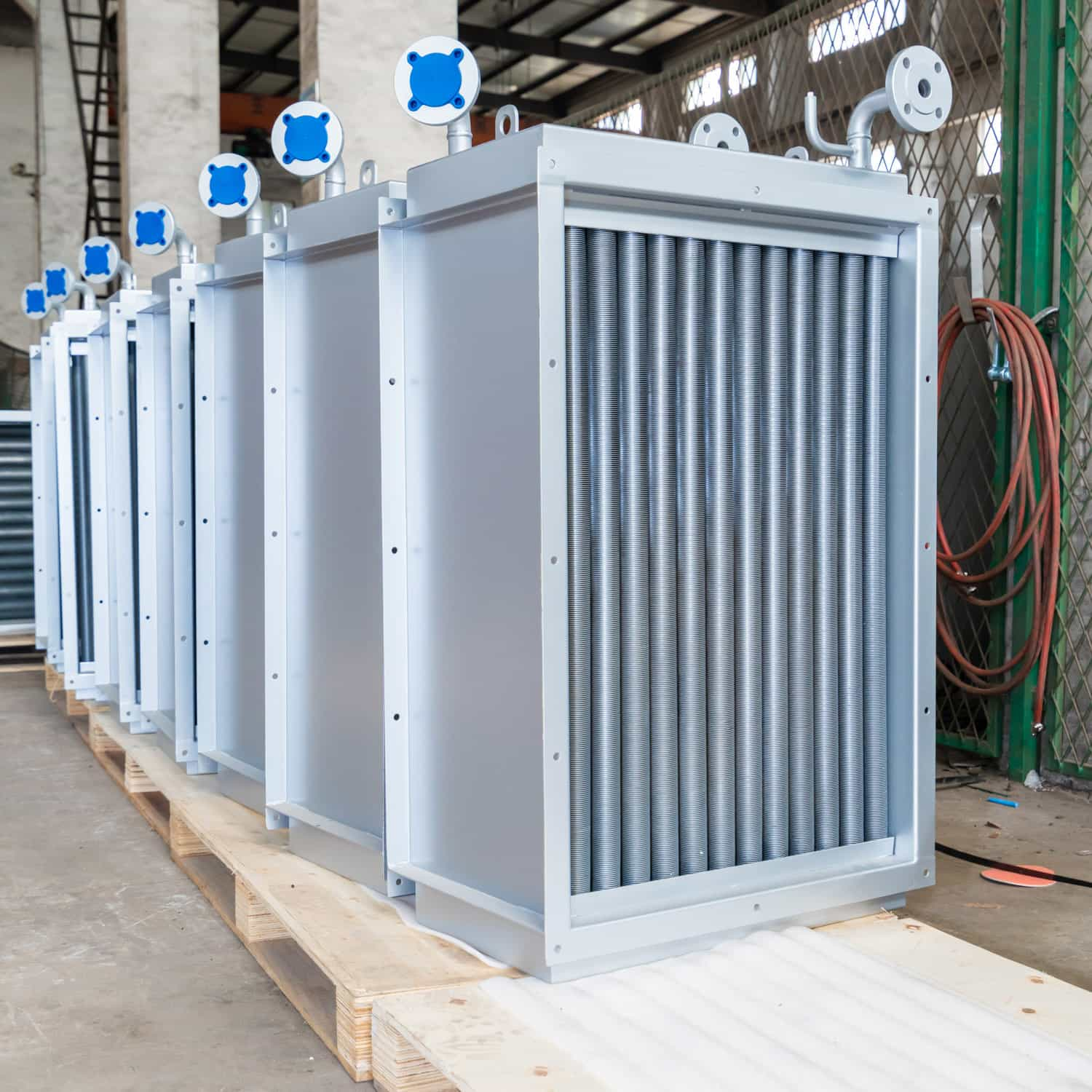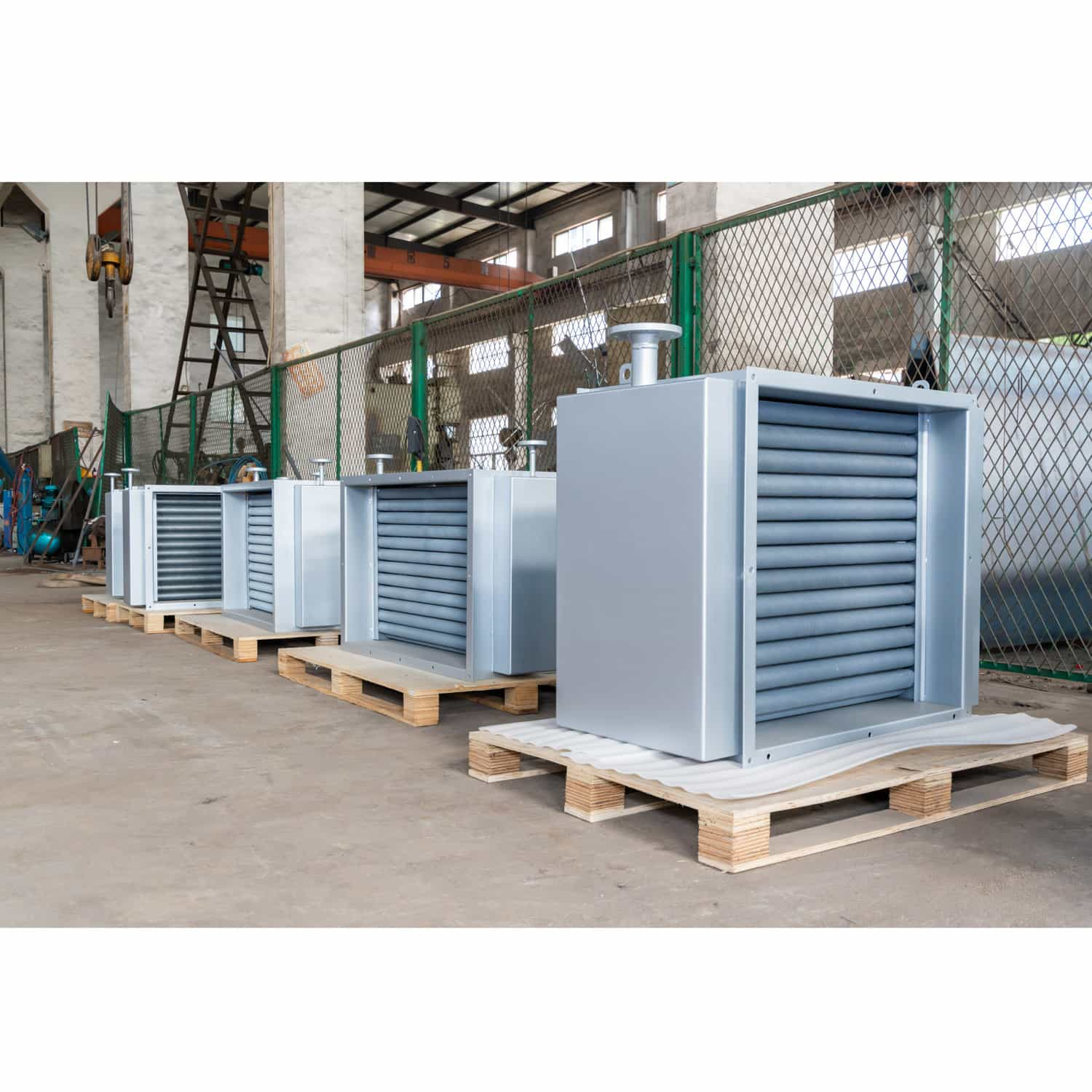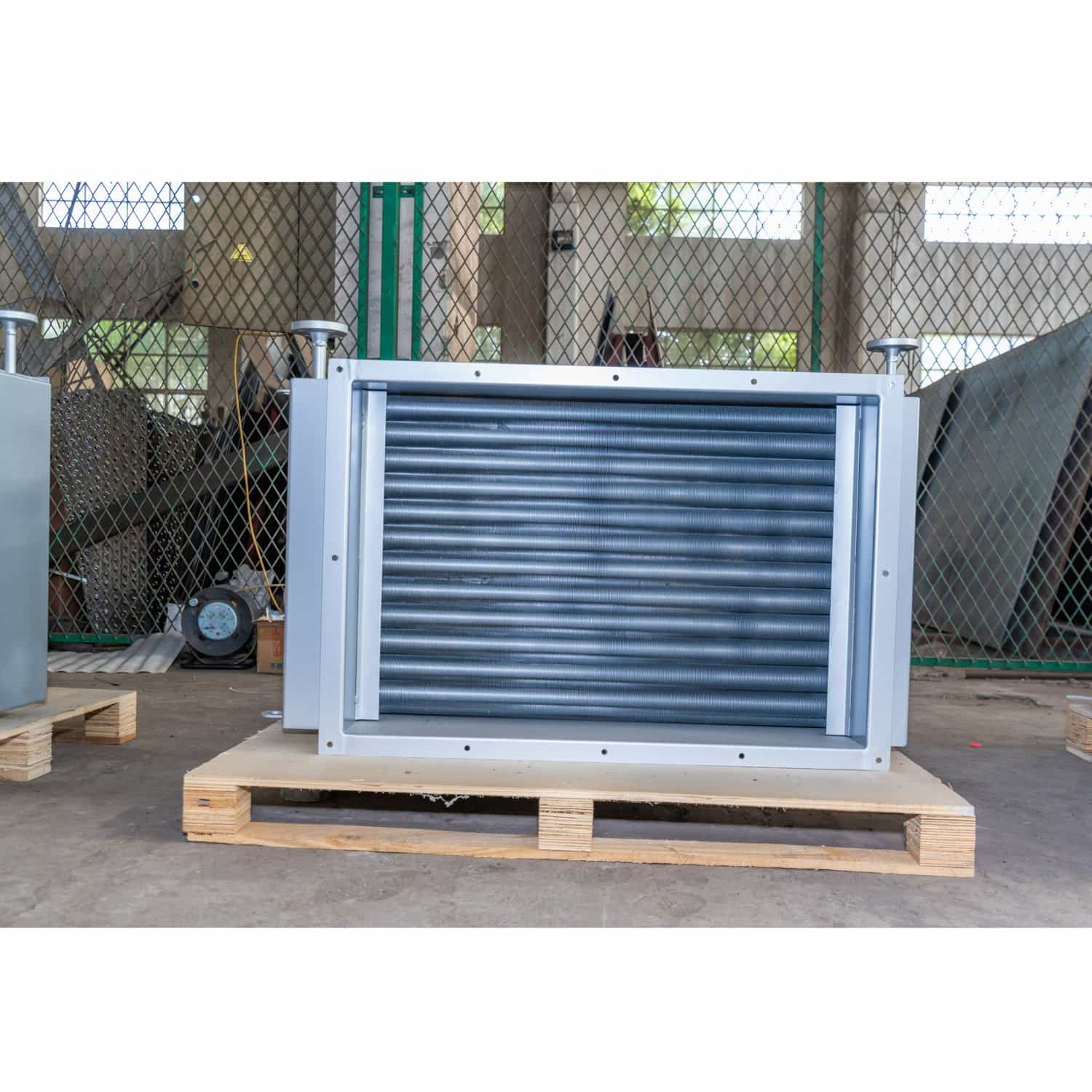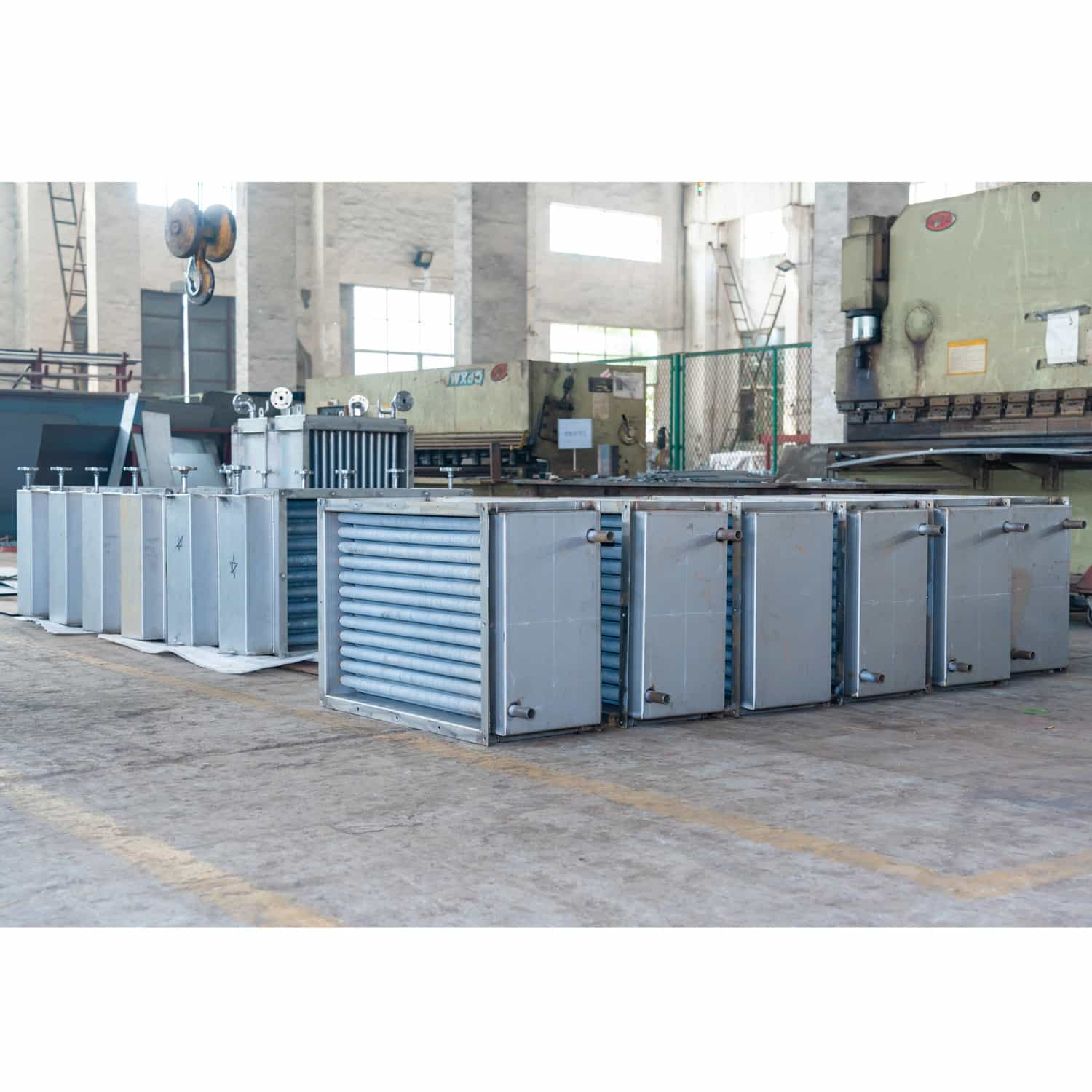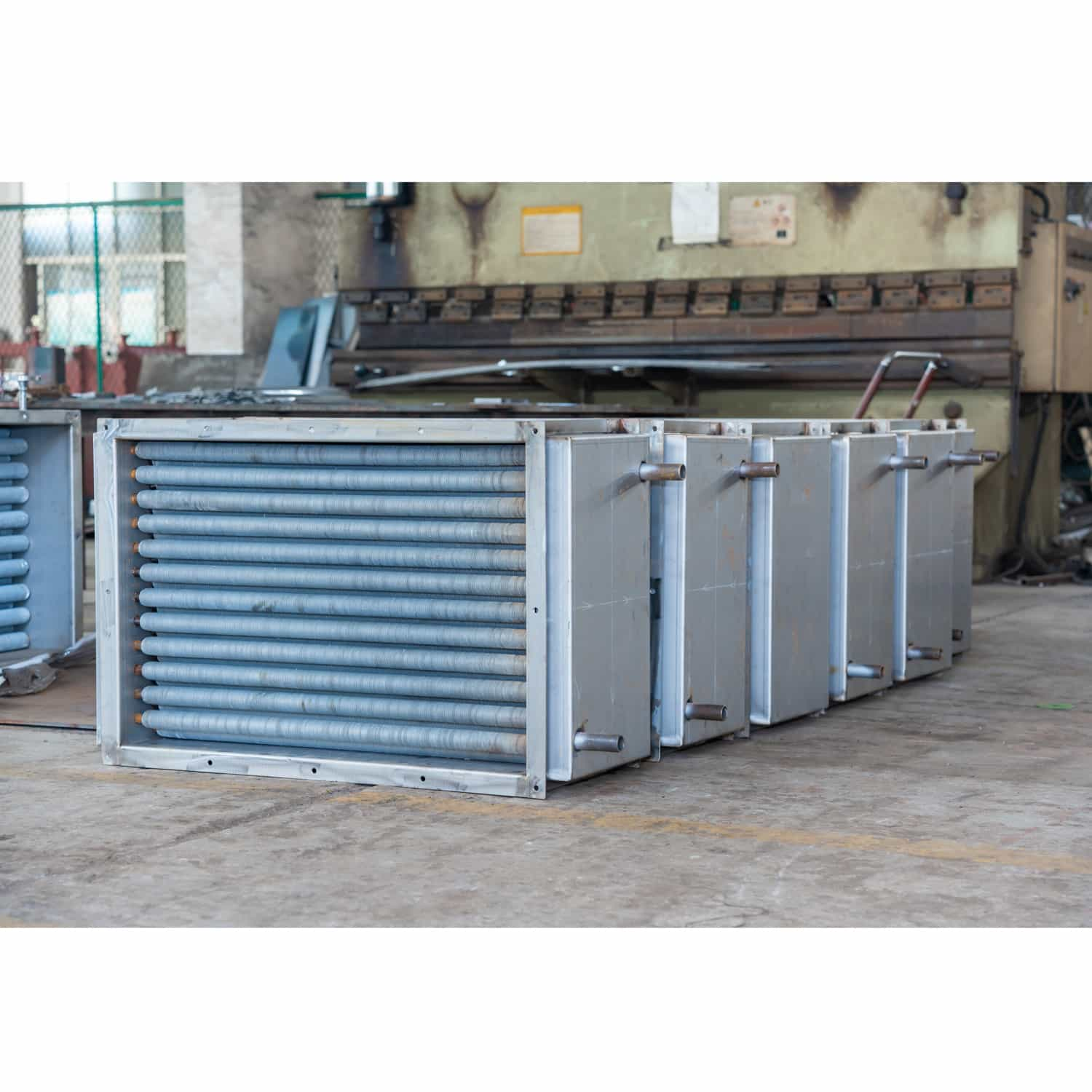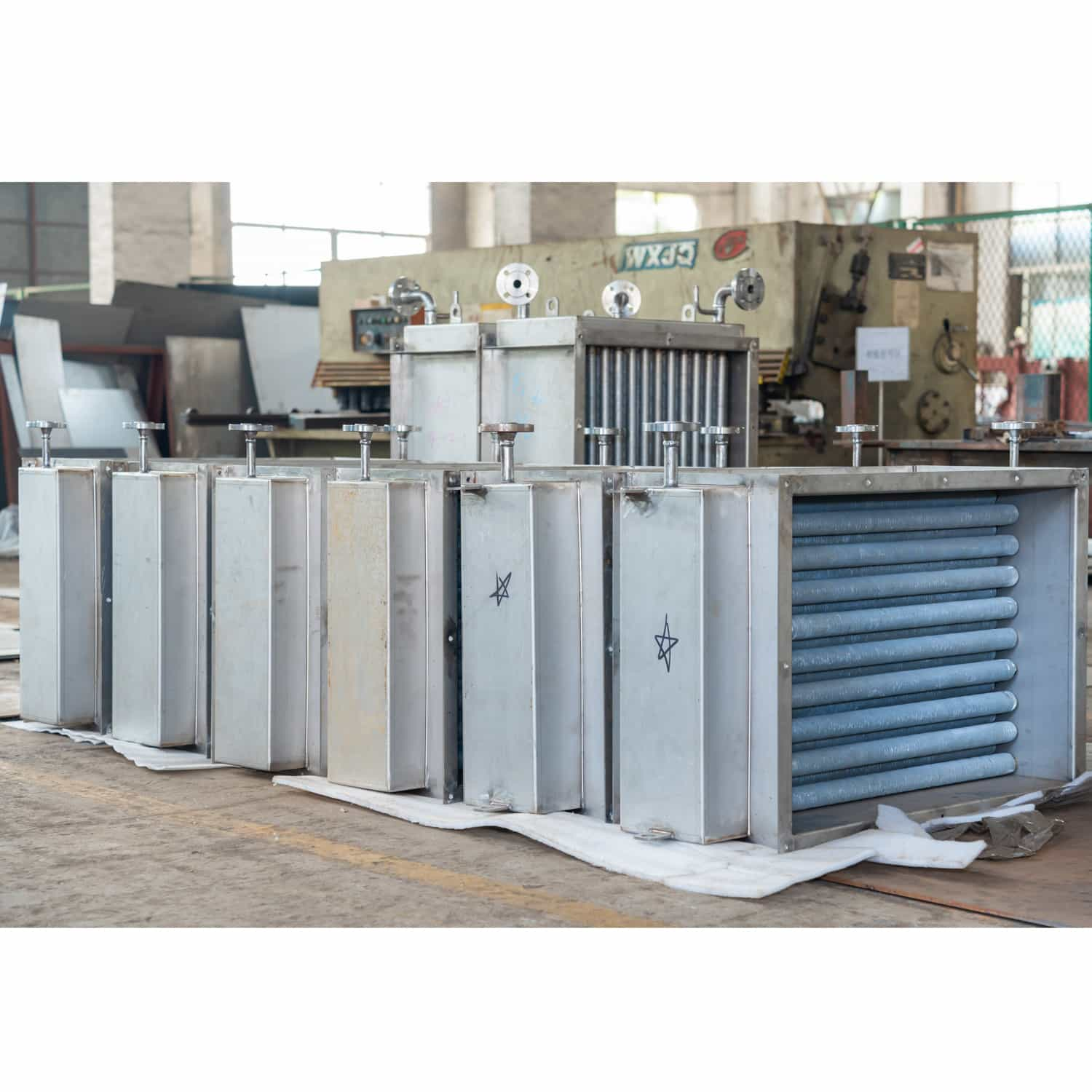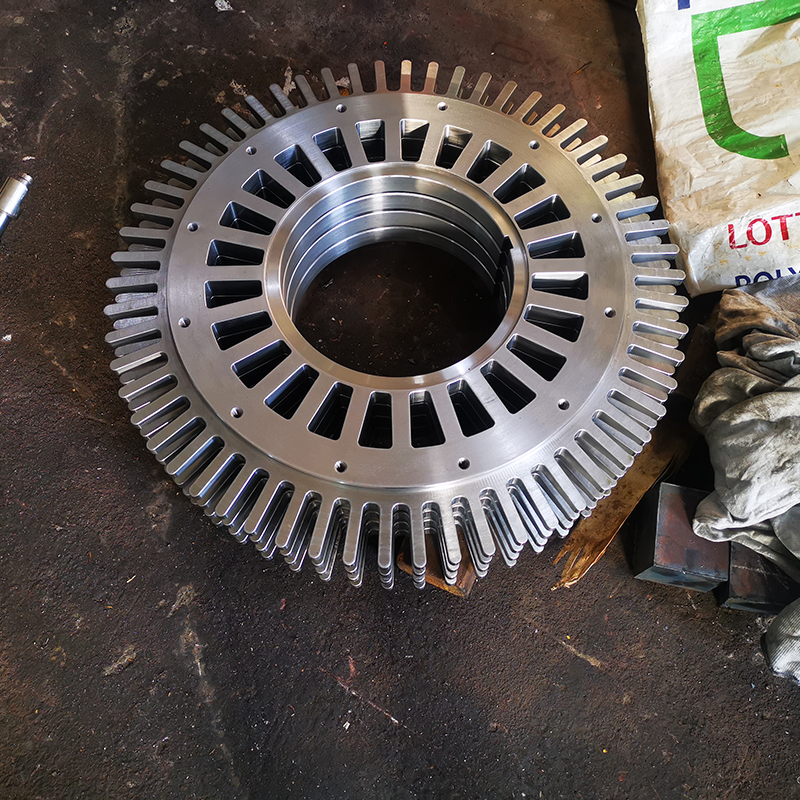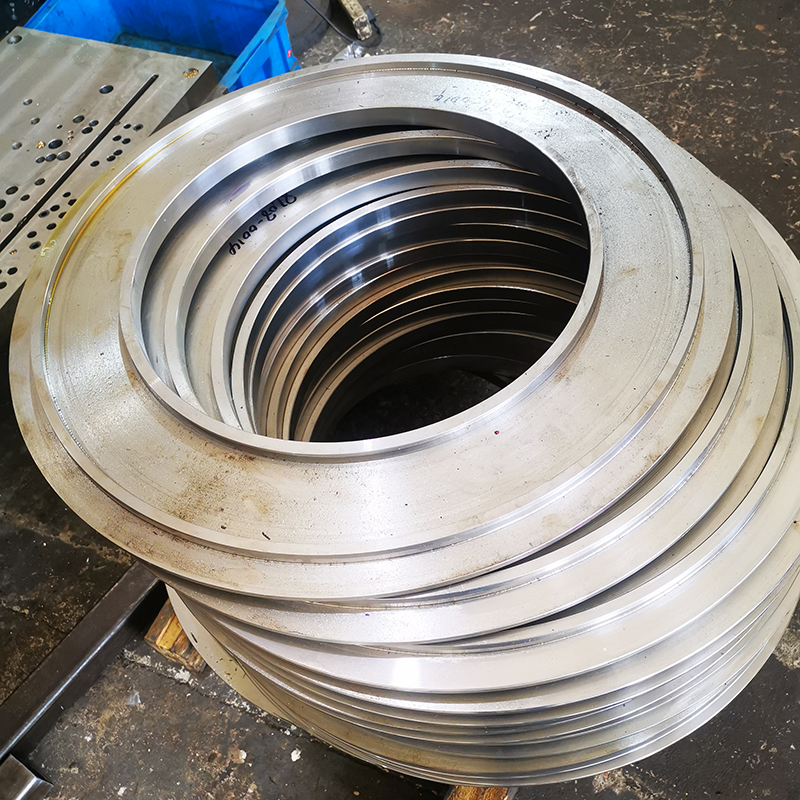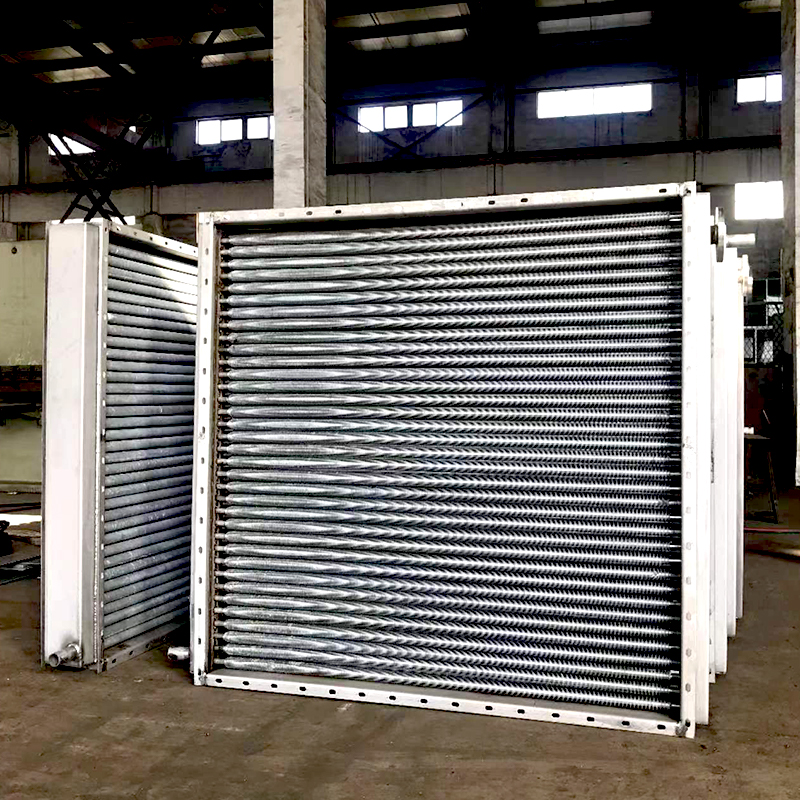Product specifications:
Material: stainless steel, copper alloy, aluminum alloy
Surface coating type: anti-corrosion coating
Tolerance range: ±0.01mm
Processing method: milling, welding, heat treatment
Quality inspection: X-ray inspection, ultrasonic inspection, pressure test
1. Structural principle of tubular heat exchanger
The tubular heat exchanger consists of a shell, a heat transfer tube bundle, a tube sheet, a baffle (baffle) and a tube box. The shell is mostly cylindrical, with a tube bundle inside, and both ends of the tube bundle are fixed on the tube sheet. The hot and cold fluids for heat exchange, one of which flows in the tube, is called the tube-side fluid; the other flows outside the tube, called the shell-side fluid. In order to improve the heat transfer coefficient of the fluid outside the tube, several baffles are usually installed in the shell. The baffle can increase the speed of the shell-side fluid, forcing the fluid to pass through the tube bundle multiple times along a specified route, and enhancing the turbulence of the fluid. The heat exchange tubes can be arranged in an equilateral triangle or square on the tube sheet. The equilateral triangle is compactly arranged, the turbulence of the fluid outside the tube is high, and the heat transfer coefficient is large. The square arrangement is convenient for cleaning outside the tube and is suitable for fluids that are prone to scaling.
2. Advantages of tubular heat exchangers
The tubular heat exchanger is easy to manufacture, has low production cost, a wide range of material selection, is easy to clean, has strong adaptability, large processing capacity, reliable operation, and can adapt to high temperature and high pressure. Although it cannot be compared with plate and plate-fin heat exchangers in terms of compact structure, light heat transfer, and unit metal consumption, it still occupies a leading position in applications in the chemical, petroleum and energy industries due to the aforementioned advantages.
3. Principles for selecting the head of a tubular heat exchanger: 1. Whether the shell side needs to be cleaned; 2. Whether the tube bundle needs to be moved; 3. Whether thermal expansion needs to be considered; Front end type: a, b, c, d, n Rear head type: l, m, n, p, s, t, w Rear heads are divided into fixed type, floating head type and U-tube. Compared with the fixed type, the floating head type has a higher cost, a larger shell diameter, and a lower heat exchange effect (due to leakage C). Its advantage is that one end has the freedom to deal with thermal expansion problems.
Author: Baolan Academy
Link: https://zhuanlan.zhihu.com/p/694081093
Source: Zhihu
Copyright belongs to the author. For commercial reproduction, please contact the author for authorization. For non-commercial reproduction, please indicate the source.
1. How are heat exchange equipment classified?
Answer: According to the “Equipment Classification Catalog of Petrochemical Corporation”, it can be divided into:
(1) Shell and tube heat exchanger
(2) Tube heat exchanger
(3) Water-immersed heat exchanger
(4) Spray heat exchanger
(5) Rotary (coil) heat exchanger
(6) Plate heat exchanger
(7) Plate-fin heat exchanger
(8) Tube-fin heat exchanger
(9) Waste heat boiler
(10) Others
2. How does the heat exchanger transfer heat?
Answer: In the most common wall-type heat exchanger, the main heat transfer methods are conduction and convection. The hot fluid first transfers heat to one side of the tube wall by convection, then transfers heat from one side of the tube wall to the other side by conduction, and finally the other side of the tube wall transfers heat to the cold fluid by convection, thus completing the heat transfer process of the heat exchanger.
3. What is the effect of the medium flow rate on the heat exchange effect?
Answer: The greater the flow rate of the medium in the heat exchanger, the greater its heat transfer coefficient. Therefore, increasing the flow rate of the medium in the heat exchanger can greatly improve the heat exchange effect, but the negative impact of increasing the flow rate is that it increases the pressure drop through the heat exchanger and increases the energy consumption of the pump, so there must be a certain suitable range.
4. What is the effect of the surface structure of the heat exchange tube on the heat exchange effect?
Answer: The use of specially designed heat exchange tube surface structures, such as finned tubes, nail head tubes, threaded tubes, etc., on the one hand increases the heat transfer area, and on the other hand, the turbulence of the special surface greatly increases the turbulence of the fluid outside the tube. Both aspects can improve the overall heat exchange effect of the heat exchanger, so these surface structures are better than the performance of the bare tube surface.
5. What are the commonly used methods for descaling the surface of heat exchange tubes?
Answer: Common methods for descaling the surface of heat exchange tubes are:
Mechanical descaling: manual descaling with steel chisels, descaling with pressurized water
Chemical descaling
6. What methods are there for preventing scale on the surface of heat exchange tubes?
Answer: (1) Nickel-phosphorus plating
(2) Chemical coating, 847 coating
7. What are the common methods for enhancing heat transfer in heat exchange equipment?
Answer: The main methods for enhancing heat transfer in heat exchange equipment
The first is to use a structure that increases the heat transfer surface, such as
1) Using finned tubes, nail head tubes, threaded tubes, bellows, etc.
2) Mechanical processing of the tube surface: spiral ring tubes, spiral groove tubes, threaded tubes, etc.
3) Using small-diameter tubes can increase the number of tubes on the same tube sheet area and increase the heat transfer area
The second is to increase the flow rate of the fluid in the heat exchanger, which can greatly improve its heat transfer coefficient, such as:
1) Adding spoilers, such as inserting spiral strips in the tube, setting baffles and dummy tubes outside the tube, etc.
2) Increasing the number of tube passes or shell passes
In addition, using materials with good thermal conductivity to manufacture heat exchangers, taking anti-corrosion and anti-scaling measures for heat exchangers, and timely cleaning of scale are all means to improve the heat transfer effect.
8. When overhauling a shell-and-tube heat exchanger, what are the requirements for the number of blocked tubes?
Answer: Corrosion and perforation of individual tubes in the tube bundle are allowed to be blocked with a processed metal plunger with a taper of 3 to 5°. Generally, in the same tube pass, the number of blocked tubes does not exceed 10% of the total number of tubes, but it can be appropriately increased according to process requirements.
9. Why must the gaskets on both sides of the tube sheet be made of the same material?
Answer: Because the flange fastening bolts on both sides of the tube sheet are the same bolts, the specific pressure applied to the gaskets on both sides of the tube sheet is the same.
If different materials are selected for the gaskets on both sides, it is inevitable that the specific pressure of one side of the gasket is insufficient, resulting in sealing failure, or the specific pressure of the other side of the gasket is too large, resulting in sealing failure. Therefore, the gaskets on both sides of the tube sheet must be made of the same material.
10. Why does the cooling water heat exchanger produce scale?
Answer: Scale is formed by the crystallization of dissolved salts in water and adheres to the wall of the heat exchanger tube. It is characterized by being dense and hard, firmly attached and difficult to remove.
A large number of suspended particles in the water can become crystal seeds. Other impurity ions, bacteria, rough metal surfaces, etc. have a strong catalytic effect on the crystallization process, greatly reducing the supersaturation required for crystallization. Therefore, scale is easily produced in cooling water heat exchangers.
11. What are the main components of floating head heat exchangers?
Answer: The main components are: tube bundle, baffle, anti-collision plate, tie rod, fixed distance tube, shell, tube box, tube sheet, inlet flange, outlet flange, floating tube sheet, floating head flange, floating head cover, floating head hook ring, floating head gasket, outer head cover flange, outer head cover side flange, outer head cover, outer head cover gasket, vent, drain, tube box flange, tube box side flange, tube box gasket, tube box side gasket, fixed saddle, movable saddle.
12. What are the main components of fixed tube sheet heat exchangers?
Answer: The main components are: tube bundle, baffle, tie rod, distance tube, shell, tube box (top cover), tube sheet, inlet flange, outlet flange, tube box flange, tube box gasket, fixed saddle, movable saddle, ear support, expansion joint.
13. What are the main components of U-tube heat exchanger?
Answer: The main components are: U-tube bundle, baffle, anti-impact plate (inner guide tube), tie rod, distance tube, shell, tube box, tube sheet, inlet flange, outlet flange, tube box flange, tube box side flange, tube box gasket, tube box side gasket, fixed saddle, movable saddle.
14. What are the main components of shell-and-tube heat exchanger?
Answer: The main components of shell-and-tube heat exchanger are: inner tube, outer tube, return elbow
15. What are the main components of water-immersed heat exchanger?
Answer: The main components of water-immersed heat exchanger are: inlet pipe, outlet pipe, manifold, coil, cooling water tank.
16. What are the main components of spray heat exchanger?
Answer: The main components of the spray heat exchanger are: tube bundle, fan, water nozzle, drain pipe, water pump.
17. What are the characteristics of fixed tube sheet heat exchanger, U-tube heat exchanger, and floating head heat exchanger?
Answer: The characteristics of the fixed tube sheet heat exchanger are compact structure, simple, low cost, the largest number of tubes in the same shell diameter, convenient single tube replacement and maintenance, convenient cleaning inside the tube, but difficult cleaning outside the tube, and large temperature difference stress between the tube and the shell.
The characteristics of the U-tube heat exchanger are simple structure, no temperature difference stress problem, high fluid flow rate, low metal consumption, suitable for high temperature and high pressure fluid, the tube bundle can be pulled out to facilitate cleaning of the shell and tube, but the elbow inside the tube is not easy to clean, the number of tubes on the tube sheet is small, the tube spacing is large, there is a gap in the center of the tube bundle, and the fluid outside the tube is easy to short-circuit.
The characteristics of the floating head heat exchanger are that the tube bundle can move freely, there is no temperature difference stress problem, the tube bundle can be freely pulled out, and it is easy to clean the outside of the tube and the tube bundle, but the floating head structure is complex, the cost is high, the sealing requirements at the floating head are strict, and the floating head is easy to leak during operation and is not easy to check and find.
18. Where are fixed tube sheet heat exchangers suitable for?
Answer: Fixed tube sheet heat exchangers are suitable for shell-side media that are clean, not easy to scale, and the medium temperature difference is relatively small.
19. Where are U-tube heat exchangers suitable for?
Answer: U-tube heat exchangers are suitable for high temperature and high pressure occasions with large temperature difference between tube and shell walls and clean medium in the tube
20. Where are floating head heat exchangers suitable for?
Answer: Floating head heat exchangers are suitable for occasions with large temperature difference between tube and shell, unclean medium, and frequent cleaning.
21. The arrangement of shell and tube heat exchangers includes triangular arrangement and square rotation 45° angle arrangement. Why?
Answer: Triangular arrangement and square rotation 45° angle arrangement each have their own advantages and disadvantages. The advantages of triangular arrangement are compactness, high heat transfer efficiency, and the largest number of tubes on the same tube sheet area, about 15% more than the square arrangement, but it is not easy to clean the outer surface of the tube; while the square arrangement with a 45° angle is more convenient for cleaning the outer surface of the tube, but the number of tubes is much less than the triangular arrangement.
22. What are the materials commonly used for tubes in shell-and-tube heat exchangers?
Answer: Commonly used tube materials are: 10#, 20#, 12CrMo, 15CrMo, 0Cr13, 1Cr13, 1Cr5Mo, 0Cr18Ni9Ti, 1Cr18Ni9Ti, titanium tube, 410, 321, etc.
23. In shell-and-tube heat exchangers, why are the tube diameters selected as φ32, φ25, φ19, and φ16 respectively?
Answer: The size of the tube diameter will directly affect the performance of the heat exchanger. The smaller the tube diameter, the larger the heat transfer coefficient, and the larger the effective heat transfer area in the same volume. This can make the structure compact and save materials. However, if the pipe diameter is too small, it will also bring adverse effects. For fluids with the same flow rate, the smaller the pipe diameter, the greater the resistance during flow, and the pressure loss will increase accordingly. In addition, too thin pipes are easily blocked by dirt, making cleaning difficult. Therefore, the pipe diameter of the heat exchanger is generally 16 mm to 32 mm.
24. Why are there round and long round bolt holes on the heat exchanger support?
Answer: The bolt holes on the fixed support are round, so that the shell can be tightly fixed on the foundation. The bolt holes on the movable support are long and round, so that the shell can be freely expanded and contracted when the temperature changes, avoiding large stress to protect the equipment.
25. What are the commonly used heat exchanger gaskets?
Answer: Commonly used heat exchanger gaskets include oil-resistant asbestos pads, iron-clad pads, corrugated pads, and metal pads.
26. What should be paid attention to when selecting small floating head bolts for floating head heat exchangers?
(1) Length
(2) Wet H2S stress corrosion
(3) Temperature
27. What is the function of the baffle plate (baffle rod) in the shell-and-tube heat exchanger?
A: The baffle plate (baffle rod) in the heat exchanger can change the flow direction of the fluid in the shell side, increase the flow rate of the fluid in the shell side, increase the turbulence of the medium, improve the heat transfer efficiency and support the tube bundle.
28. Why are there single-pass, two-pass, four-pass, six-pass and eight-pass tubes in the shell-and-tube heat exchanger?
A: When the total number of tubes in the heat exchanger is the same, increasing the number of tube passes can increase the flow rate in each tube pass, thereby increasing the heat transfer coefficient and reducing the required heat transfer area. However, it also increases the pressure drop, and prevents the fluid from fully exchanging heat in a countercurrent manner, and the heat exchanger structure becomes more complicated. Therefore, the number of tube passes generally used is not less than 2 and not more than 8, and the specific number should be selected according to the actual process requirements.
29. What are the causes of internal leakage in shell-and-tube heat exchangers?
Answer: The following reasons may be the causes of internal leakage in the heat exchanger:
Corrosion perforation or breakage of the heat exchange tube
Corrosion and thinning of the tube mouth causing leakage
Loosening of the expansion joint between the heat exchange tube and the tube sheet
Cracks, pores or corrosion perforation at the welding point between the heat exchange tube and the tube sheet
Loosening or breaking of the small floating head bolt
Damage of the small floating head gasket
Damage of the small floating head or floating tube sheet seal
30. Why do we need to test the water pressure after the heat exchanger is overhauled?
Answer: The purpose of testing the water pressure after the heat exchanger is overhauled is to check whether the heat exchanger has the ability to safely withstand the design pressure (i.e., pressure resistance), tightness, quality of the interface or joint, welding quality and tightness of the sealing structure. In addition, the residual deformation of the parent material welds of the container and the pipeline after pressure can be observed to promptly discover problems with the material.
31. Why are some shell-and-tube heat exchangers installed vertically and some horizontally (horizontally)?
Answer: Some shell-and-tube heat exchangers are vertical and some are horizontal. The main considerations are as follows:
①Production process requirements: For example, some reboilers require a certain medium liquid level height. If a horizontal heat exchanger is used, the liquid level height requirement cannot be met, so a vertical heat exchanger must be selected;
②Large-scale: If a process unit requires a heat exchange area of several thousand square meters, if a horizontal heat exchanger with a heat pipe length of 6 meters is selected, several heat exchangers may be required, which occupies a large area and is not conducive to the effective spatial layout of the device. If a vertical heat exchanger with a heat exchange tube length of 12 meters is selected, one unit can solve the problem;
③Reduce pressure drop: Some production processes require minimizing the pressure drop in the medium transportation process. Choose a vertical heat exchanger and arrange it in parallel with the tower to shorten the connecting pipeline with the tower and reduce the pressure drop.
32. Why do some places choose shell-and-tube heat exchangers and water-immersed heat exchangers, while others choose shell-and-tube heat exchangers?
A: At present, the heat exchange equipment selected by oil refining and chemical production equipment is mostly shell-and-tube heat exchangers, but in some production equipment, there are still a small number of shell-and-tube heat exchangers and water-immersed heat exchangers. Although the shell-and-tube heat exchanger has a compact structure and high heat exchange efficiency, it is easy to cause blockage if used for media containing solid particles due to the small heat exchange tubes. Therefore, in places where the medium contains solid particles, shell-and-tube heat exchangers or water-immersed heat exchangers are generally selected.
Contact Information for Heat Exchanger Tube Inquiries
For more information about Heat Exchanger Tube or to obtain customized solutions, please contact us:
Contact Person: Frank
Tel: 86-510-82305188-8060
Mobile: 86-18605101203
Mail: frankgu@cmecwuxi.com
Address: 15-16F, Building A10, No. 777, JianZhu West Road, Binhu District, Wuxi, Jiangsu, 214072. P.R. China
We look forward to collaborating with you and providing robust support and services for your business.

